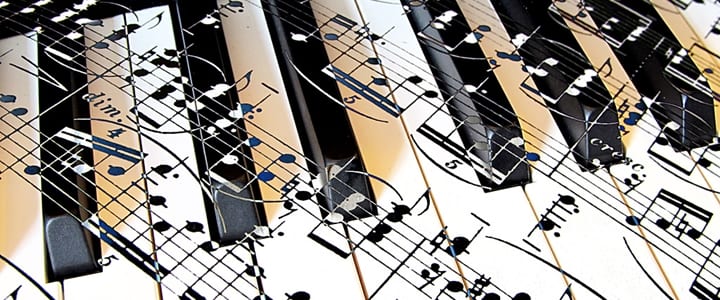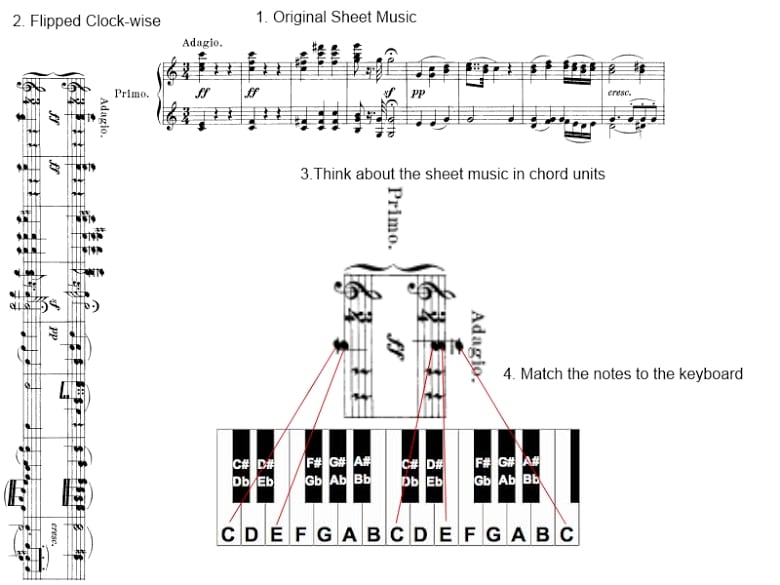As a beginner, learning how to read sheet music for piano is one of the first things you’ll work on with your teacher. Read on as Tucson, AZ tutor Blake C. shares his strategy for understanding the relationships between the notes on the page:
One of the most difficult things about learning how to read sheet music for the piano, as opposed to most other instruments, is that there is not just a single melody to be played. Piano music requires you to play more the one part at a time. Usually these parts are interconnected; they are part of a chord that you need to be able to quickly and accurately read by octave and finger placement.
A Little History
Sheet music is read from left to right. This reasoning behind this is that music began as an exercise most focused on the progression of notes in a scale or mode in a horizontal fashion. When more than one voice was sounded together, they usually sang in unison and it was not till the 9th c. that musicians became increasingly concerned with vertical harmony and polyphony.
Keyboard instruments, such as the organ, the harpsichord, and ultimately the piano were instruments developed to satisfy this changing aesthetic and the increased importance of vertical harmonies, but they were adapted into a notation that had been developed to address primarily horizontal concerns (i.e. what note comes next). This is not to say that sheet music cannot be read for the piano, but rather that the beginning student of piano must learn to think about the music on the page differently than they might read words on a page or read a single melody line. You must flip the orientation of the sheet music in front of you mentally, so you they can read the vertical orientation of the notes.
A Helpful Strategy
In order to begin to think about and practice this mental flip there is an extremely helpful strategy you can use. You can actually turn the sheet music so you are reading the notes down the page. Doing so allows you to more easily understand the spacing between the notes and more intuitively grasp where your fingers should be placed on the keys. This technique is also incredibly helpful for visualizing the grand staff as a whole and where the octaves on the keyboard are located.
In order to properly perform this strategy and learn how to read sheet music for piano, follow these 3 simple steps:
-
Take your original sheet music and flip it clockwise. It should be the case that the line of music you’re working on playing can be read down the page, from top to bottom, instead of across the page.
-
Begin to identify chord units and think about each measure in terms of chordal units. Most bars or measures of beginning piano music contain one or two chords. Sometimes these chords are arpeggiated, other times there is an alternation pattern of notes in the treble and bass in quick succession. Your success with this technique depends on your ability to identify which chord is being outlined. To do this, simply name the notes; in beginning sheet music you’ll most likely see either major or minor triads.
Match the notes on the page to your fingers on the keyboard. Notice how, with the sheet music turned, the sheet music is actually a diagram of the intervals between each note and how this realization helps you to visualize where to place your fingers.
Here’s how it looks on your sheet music:
General Advice
With music, there are many different strategies that can help you move on to a better understanding. Everyone approaches music differently. Some musicians intuitively grasp complex concepts, others need a little help along the way. Some may even find the strategy more confusing than the standard approach.
Whether or not this technique is right for you depends largely on whether or not it yields a type of “aha” moment, where you can better visualize the spacing of your fingers and their placement on the keys. With anything you ever try with music, or anything else for that matter, don’t be afraid to move on to a new way of looking at it if a technique is not a helpful one.
 Blake C. tutors in various subjects, including math, reading, and SAT prep, in Tucson, AZ and online. A Flinn Scholar, Blake C. graduated from The University of Arizona with a degree in Business Management in 2007 and later returned for a second Bachelor’s in Music Theory History and Criticism which was awarded in December of 2013. Learn more about Blake here!
Blake C. tutors in various subjects, including math, reading, and SAT prep, in Tucson, AZ and online. A Flinn Scholar, Blake C. graduated from The University of Arizona with a degree in Business Management in 2007 and later returned for a second Bachelor’s in Music Theory History and Criticism which was awarded in December of 2013. Learn more about Blake here!
Photo by Andrew Gustar
Suzy S.



